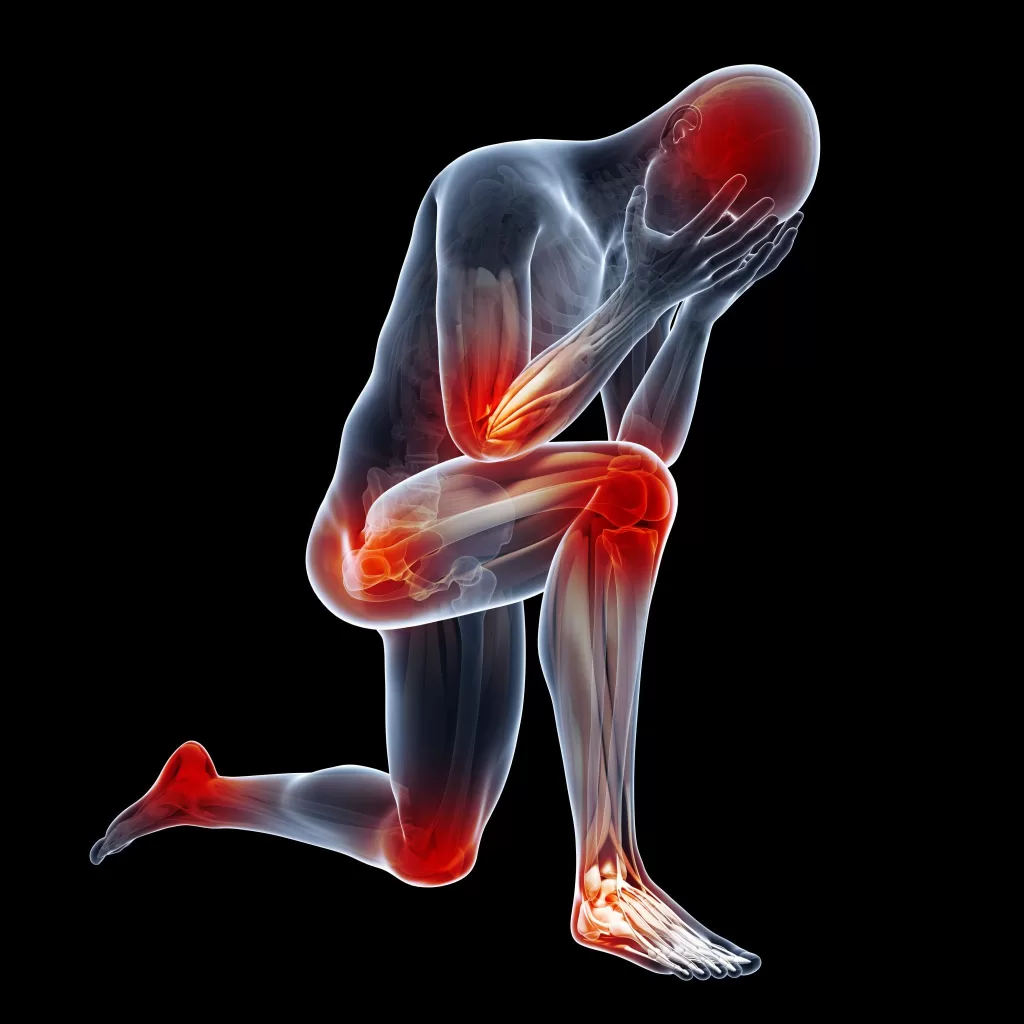Bursitis is an inflammatory condition that impacts many individuals, especially those vulnerable to joint pain. Primarily affecting the hip, elbow, and shoulder areas, understanding bursitis is crucial for alleviating discomfort and enhancing mobility. With proper knowledge of the specific shoulder bursitis symptoms and effective hip bursitis treatment options, individuals can take significant steps toward improving their quality of life. Likewise, elbow bursitis management and targeted bursitis exercises can aid in prevention, ensuring that joint health remains a priority. This introductory guide will navigate through the complexities of bursitis, offering insights into its causes, symptoms, and effective strategies for management.
Inflammation of the bursae, which are fluid-filled sacs that cushion joints, is commonly referred to as bursitis. This condition, which can manifest in various forms, such as hip bursitis, elbow bursitis, and shoulder bursitis, often leads to pain and reduced mobility. Recognizing the signs of bursitis is essential for effective treatment and management, as well as for understanding preventative measures. Through targeted exercises and modifications in daily activities, individuals can prevent the discomfort and complications that arise from bursitis. This article aims to explore the intricacies of this condition and present comprehensive solutions.
Understanding Bursitis: Types and Symptoms
Bursitis is an inflammation of the bursae, small fluid-filled sacs that provide cushioning between bones, tendons, and muscles near the joints. This condition primarily affects areas such as the hips, elbows, and shoulders, each presenting its own set of symptoms. For instance, hip bursitis often manifests as pain on the outer side of the hip, making it particularly challenging for individuals to lie down on the affected side or climb stairs. On the other hand, elbow bursitis can lead to noticeable swelling at the elbow’s tip, which can cause sharp pain, especially during arm movements.
In the case of shoulder bursitis, individuals may experience a persistent dull ache that intensifies when raising the arm overhead. These symptoms not only signal an issue with the bursae but also indicate potential mobility limitations. Recognizing the early signs of bursitis can lead to timely interventions, preventing the progression into chronic pain or further joint complications. It’s essential for individuals experiencing symptoms of bursitis to seek appropriate medical care to manage their condition effectively.
Effective Treatment Options for Bursitis
Managing bursitis effectively requires a comprehensive approach that may include rest, medication, and physical therapy. Initially, individuals are advised to modify their activities to avoid exacerbating their symptoms; this means taking breaks from repetitive tasks or activities that put excessive strain on the affected joint. Ice therapy can also be beneficial in the initial stages, as applying ice can help reduce swelling and provide immediate pain relief. Nonsteroidal anti-inflammatory drugs (NSAIDs), like ibuprofen, are frequently recommended to manage pain and inflammation associated with bursitis.
In more severe cases, physical therapy can be an essential component of treatment. Through guided exercises, physical therapists can help strengthen the muscles around the affected joint, which in turn may lessen the burden on the bursae. Additionally, corticosteroid injections provide relief for persistent discomfort and significantly reduce inflammation when other treatments fail to work. For chronic cases that do not respond to conservative treatment, surgical options may be considered, although these are rare.
Bursitis Prevention: Strategies You Can Implement
Preventing bursitis involves a proactive approach to joint health and activity management. One effective strategy is to ensure adequate warm-up and stretching before any physical activities. This not only prepares the body for movement but also helps protect the bursae from undue stress. Additionally, creating ergonomic workspaces can minimize the risk of repetitive strain injuries, especially for those in physically demanding occupations.
Another key prevention strategy includes engaging in strength-building exercises focused on the muscles surrounding the joints. Such exercises can enhance joint stability and help distribute forces more evenly, thereby reducing pressure on the bursae. Furthermore, managing existing health conditions like arthritis effectively serves to lower the risk of developing bursitis. By implementing these preventive measures, individuals can maintain joint health and lower the incidence of bursitis.
Spotting the Symptoms: When to Seek Help
Recognizing the symptoms of bursitis can significantly affect the management of the condition. If you experience persistent pain around the joints, swelling, or tenderness that doesn’t improve with home treatment, it may be necessary to seek medical attention. Ignoring these symptoms could lead to more complex issues, complicating the recovery process and potentially resulting in chronic pain conditions.
Responsive care is vital; therefore, individuals are encouraged not to delay a consultation with a healthcare professional if symptoms persist or severely impact daily functioning. A timely diagnosis and targeted treatment plan can not only relieve the immediate pain of bursitis but also pave the way for a complete recovery, allowing individuals to regain mobility and return to their regular activities.
Living Well with Bursitis: Lifestyle Adjustments
Living with bursitis can be challenging, but making the right lifestyle adjustments can greatly alleviate discomfort and improve quality of life. Incorporating activities that promote joint health, such as low-impact exercises, can help strengthen surrounding muscles while minimizing strain on the bursae. Swimming, biking, and walking are excellent choices that keep joints active without heavy impact.
Additionally, individuals should pay attention to their body mechanics during daily tasks to prevent undue stress on the affected joints. Simple adjustments, like lifting objects correctly and avoiding prolonged periods in one position, can significantly lower the chances of exacerbating bursitis pain. By understanding how lifestyle choices impact their condition, individuals can take charge of their joint health and lead more fulfilling lives despite the challenges of bursitis.
Frequently Asked Questions
What are the common symptoms of shoulder bursitis?
Shoulder bursitis typically presents with symptoms such as a dull ache in the shoulder, pain when lifting the arm overhead, and tenderness in the surrounding area. Individuals may also experience discomfort during certain activities, prompting the need for prompt diagnosis and management.
How can hip bursitis treatment help alleviate pain?
Hip bursitis treatment involves several strategies, including rest, ice therapy, and anti-inflammatory medications. Engaging in physical therapy can significantly improve strength and flexibility in the hip region, ultimately reducing pain and facilitating recovery.
What can be done for elbow bursitis management?
For effective elbow bursitis management, patients are advised to rest the joint, apply ice for inflammation, and consider over-the-counter pain relief medications. If symptoms persist, corticosteroid injections or physical therapy may provide additional benefits.
How can one focus on preventing bursitis?
Preventing bursitis involves strategies such as proper warm-up before activities, maintaining ergonomic workspaces, and practicing strength-building exercises. Regularly managing underlying conditions like arthritis is also essential to reduce the risk of developing bursitis.
What types of bursitis exercises are recommended for recovery?
Recommended bursitis exercises typically include gentle stretching and strengthening routines aimed at the affected joints. For those with shoulder bursitis, range-of-motion exercises can help keep the shoulder flexible while reducing reliance on painful movements.
| Aspect | Details |
|---|---|
| Definition of Bursitis | Inflammation of the bursae, leading to joint pain and discomfort, mainly affecting the hip, elbow, and shoulder. |
| Symptoms | Hip: Pain in the outer hip/thigh, exacerbated by sleeping on the side, walking, or stairs. Elbow: Swelling at the elbow’s tip; pain worsens with movement. Shoulder: Dull ache in shoulder with increased pain when lifting the arm overhead. |
| Causes/Risk Factors | Repetitive motions, injuries, aging, and underlying conditions like arthritis or diabetes increase risk. |
| Diagnosis | Involves reviewing medical history, physical examination, and imaging tests like X-rays or MRIs. |
| Treatment Options | Rest, ice therapy, NSAIDs, physical therapy, corticosteroid injections, and rarely, surgery. |
| Prevention Strategies | Warm-up/stretching before activities, ergonomic workspaces, strength training around joints, and managing chronic conditions. |
| When to Seek Help | If symptoms persist or worsen despite treatment, consult a healthcare professional to avoid complications. |
Summary
Bursitis is a painful condition that affects individuals by causing inflammation in the bursae located near joints such as the hip, elbow, and shoulder. Recognizing early symptoms is critical in managing this ailment effectively. The inflammatory response in the bursae can lead to significant discomfort during movement, which can severely impact daily activities. Seeking appropriate treatment options, such as rest and physical therapy, along with preventive strategies, plays a vital role in alleviating symptoms and promoting joint health. By understanding bursitis and implementing proactive measures, individuals can enhance their quality of life and reduce the risks associated with this common yet often misunderstood condition.
The content provided on this blog (e.g., symptom descriptions, health tips, or general advice) is for informational purposes only and is not a substitute for professional medical advice, diagnosis, or treatment. Always seek the guidance of your physician or other qualified healthcare provider with any questions you may have regarding a medical condition. Never disregard professional medical advice or delay seeking it because of something you have read on this website. If you believe you may have a medical emergency, call your doctor or emergency services immediately. Reliance on any information provided by this blog is solely at your own risk.








